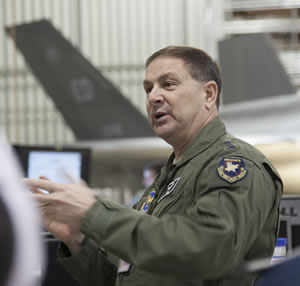

Addressing some of the main challenges of the F-35 program, Air Force Lt. Gen. Christopher C. Bogdan F-35 program executive officer (PEO) said his main goal now is meeting the remaining program goals on time and within the remaining budget.
“Particularly for two significant deadlines — 2015, when the Marine Corps is scheduled to have combat-ready aircraft; and 2017, when development is scheduled to end… Those two dates are extremely important,” Bogdan said, “because if I don’t get to those two dates or I don’t reach the finish line there, then we will continue to produce airplanes that don’t have the capability that the warfighter needs.”
The development program ends in 2017, he said, and is about 90 percent complete, with about $6 billion left in the budget. “That last 10 percent is the real hard 10 percent,” Bogdan said. “So, what I have told the enterprise is, relative to development, we have no more time, and we have no more money.”
This requires a change in mindset, the general said. Additional expenses have to be offset by a reduction elsewhere, and that, he said, may mean a reduction in end capability. “That has profound implications for the warfighter. I can honestly tell you that the warfighter does not like me standing up saying that,” Bodgan said.
“we’re still doing basic testing on the airplane. So for someone to assess that the visibility behind the airplane is such that it will ‘get gunned down every time,’ [is] a little premature.”
Referring to recent criticisms about technical issues and allegations of limited aft visibility and training deficiencies, Bogdan said it is premature to address those issues at such an early stage. “There are known solutions for all of the known issues with the aircraft”, he added.
“We have yet to fly a single air-to-air engagement with another F-35 or another airplane,” he said. “The airplane’s not ready to do that. We’re still doing basic training on the airplane, [and] we’re still doing basic testing on the airplane. So for someone to assess that the visibility behind the airplane is such that it will ‘get gunned down every time,’ [is] a little premature.”
In a speech at the McAleese/Credit Suisse Defense Programs Conference at the Newseum, Bogdan told attendees that he and his predecessor, Navy Vice Adm. Dave Venlet, worked with Lockheed-Martin and Pratt & Whitney to reform the problem-plagued development program. Today, the PEO said the program’s affordability is his leading concern.

Avoiding the ‘Death Spiral’
F-35 production is “the shining star” of the program, the general said. About 30 aircraft are being built each year, and the cost per unit has come down with each successive low-rate initial production (LRIP) lot. Between LRIP 4 and LRIP 5, there was a 4-percent decrease in build costs, Bogdan said, a trend he said he believes will continue until per-unit costs approach the original 2001 estimate of $69 million.
“we have to continue to see Lockheed-Martin and Pratt & Whitney investing in making the production line more efficient, squeezing the costs out, and getting the unit cost of this airplane down”
“I think we can get there,” he said. “Lockheed-Martin and Pratt & Whitney are doing a pretty good job of coming down that cost curve. They’re getting more efficient in their production line [and] their quality is going up, … and that is a good thing, because I promise you the one thing that our partners care most about is how much this airplane’s going to cost.”
Eight nations have committed to participate in the development program, and another three may buy F-35s, with nearly 3,000 aircraft expected to be produced. With such a large order and so many partners invested in the aircraft, it’s essential to keep costs down to avoid what Bogdan called the “death spiral,” something he said he’s seen kill off many programs.
The death spiral is when increasing costs lead to a reduction in the number of units purchased, which in turn leads to further per-unit cost increases, and so on.
“I don’t think that’s the fate of this program,” Bogdan said, “but the proof is in the pudding, and we have to continue to see Lockheed-Martin and Pratt & Whitney investing in making the production line more efficient, squeezing the costs out, and getting the unit cost of this airplane down. I think they can do it, but we have to wait and see.”
Affordability Over Life Time
Production costs are only part of the puzzle, however. About 70 to 80 percent of any program’s costs are in the long-term operation and sustainment phase, the general said. What’s unique about the F-35 is that the Defense Department has never had to estimate the costs of a 50-year aircraft life cycle, he said. Adding to the complications of producing such a cost estimate is that the department hasn’t had an aircraft program this large since World War II, Bogdan said.
“There is already interest from industry in a competitive bidding to produce, deliver and operate support equipment, pilot and maintenance training centers, administer the logistics and information technology systems and manage the global supply chain”
“So, lots of airplanes over a very long period of time, with inflation added in, you can understand how the [Office of the Secretary of Defense] guys come up with a number like $1.1 trillion,” he said. “That’s an astronomical number; it’s based on a lot of assumptions. I’m not saying that that’s a bad number; I’m just saying we need to take that number with a grain of salt.”
What he does know, he said, is that action must be taken soon to reduce the F-35’s long-term sustainment costs. Without it, the general said, a time will come when the services decide that the aircraft is no longer affordable.
“So we have to start doing things today,” Bogdan said. He said there is already interest from industry in a competitive bidding process to produce, deliver and operate support equipment and pilot and maintenance training centers, administer the logistics and information technology systems and manage the global supply chain.
“The other thing is we’ve got to work on the reliability and the maintainability of the airplane,” he said, a process he described as ‘Whack-a-Mole.’ “You’ll take care of those first 10 or 20 cost drivers in reliability and maintainability, and then the next 20 will show up,” he explained. “You keep doing that until you get to a point where the reliability and maintainability of the airplane is up where you expected it to be, and in the long term, you can reduce the costs on the airplane.”
Improving Project Management
As part of the program’s improvements linked to the 2009 rescheduling, Venlet introduced a more radical change in the engineering process. Previously, design reviews were conducted by the program office, Bogdan reminded. Design review boards are now chaired by government executives from throughout the Defense Department who are seasoned engineers with experience developing successful aircraft programs. “They draw on the expertise of all the people underneath them at those organizations to help us decide, technically, ‘Are we ready to move forward?’” he added, noting that the change has paid great dividends.
“I have a good program office, but I don’t have the resources, nor do I have the expertise that the entire Department of Defense has when it comes to building airplanes”
Some of the program changes have been painful, the general said, but were necessary. For example, until 2010 the program was operating without an integrated master schedule, so it was difficult to track the systemwide effects of a change in any part of the program. The schedule has been built, and now tracks about 16,000 items, he said. It’s a small thing that makes a big difference in how a program is managed, he noted. “We can actually track each of those events and see how they affect the end timeline,” Bogdan said.
Bogdan summarized his expectations. “We are trying to instill a level of discipline in this program such that there are no surprises, we have predictable outcomes, [and] when we have problems, we have ways of solving those problems,” he said. “[This is] very hard to do on a very big, complex program that has lots and lots of decision-makers [and] lots and lots of pots of money, but I think that’s an absolute necessity to get the program moving in the right direction.”
This article is based on review by Claudette Roulo of the American Forces Press Service.
















